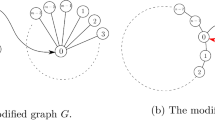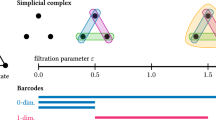Abstract
Logical modeling of biological regulatory networks gives rise to a representation of the system’s dynamics as a so-called state transition graph. Analysis of such a graph in its entirety allows for a comprehensive understanding of the functionalities and behavior of the modeled system. However, the size of the vertex set of the graph is exponential in the number of the network components making analysis costly, motivating development of reduction methods. In this paper, we present results allowing for a complete description of an asynchronous state transition graph of a Thomas network solely based on the analysis of the subgraph induced by certain extremal states. Utilizing this notion, we compare the behavior of a simple multivalued network and a corresponding Boolean network and analyze the conservation of dynamical properties between them. Understanding the relation between such coarser and finer models is a necessary step toward meaningful network reduction as well as model refinement methods.




Similar content being viewed by others
References
Abou-Jaoudé, W., Ouattara, D. A., & Kaufman, M. (2009). From structure to dynamics: frequency tuning in the p53-Mdm2 network: I. Logical approach. J. Theor. Biol., 258(4), 561–577.
Aracena, J. (2008). Maximum number of fixed points in regulatory boolean networks. Bull. Math. Biol., 70(5), 1398–1409. .
Bernot, G., & Tahi, F. (2009). Behaviour preservation of a biological regulatory network when embedded into a larger network. Fundam. Inform., 91(3–4), 463–485.
Didier, G., Remy, E., & Chaouiya, C. (2011). Mapping multivalued onto boolean dynamics. J. Theor. Biol., 270(1), 177–184.
Mabrouki, M., Aiguier, M., Comet, J. P., Gall, P. L., & Richard, A. (2011). Embedding of biological regulatory networks and properties preservation. Math. Comput. Sci., 5(3), 263–288.
Naldi, A., Carneiro, J., Chaouiya, C., & Thieffry, D. (2010). Diversity and plasticity of Th cell types predicted from regulatory network modelling. PLoS Comput. Biol., 6(9), e1000912.
Naldi, A., Remy, E., Thieffry, D., & Chaouiya, C. (2011). Dynamically consistent reduction of logical regulatory graphs. Theor. Comput. Sci., 412(21), 2207–2218.
Remy, E., & Ruet, P. (2008). From minimal signed circuits to the dynamics of boolean regulatory networks. Bioinformatics, 24(16), i200–i226.
Remy, E., Ruet, P., & Thieffry, D. (2008). Graphic requirements for multistability and attractive cycles in a boolean dynamical framework. Adv. Appl. Math., 41(3), 335–350.
Sánchez, L., Chaouiya, C., & Thieffry, D. (2008). Segmenting the fly embryo: logical analysis of the role of the segment polarity cross-regulatory module. Int. J. Dev. Biol., 52, 1059–1075.
Siebert, H. (2011). Analysis of discrete bioregulatory networks using symbolic steady states. Bull. Math. Biol., 73(4), 873–898.
Thomas, R. (1973). Boolean formalization of genetic control circuits. J. Theor. Biol., 42(3), 565–583.
Thomas, R., & d’Ari, R. (1990). Biological feedback. Boca Raton: CRC Press.
Thomas, R., & Kaufman, M. (2001). Multistationarity, the basis of cell differentiation and memory. II. Logical analysis of regulatory networks in terms of feedback circuits. Chaos, 11, 180–195.
Tournier, L., & Chaves, M. (2009). Uncovering operational interactions in genetic networks using asynchronous boolean dynamics. J. Theor. Biol., 260(2), 196–209.
Veliz-Cuba, A. (2011). Reduction of boolean network models. J. Theor. Biol., 289, 167–172.
Author information
Authors and Affiliations
Corresponding author
Rights and permissions
About this article
Cite this article
Lorenz, T., Siebert, H. & Bockmayr, A. Analysis and Characterization of Asynchronous State Transition Graphs Using Extremal States. Bull Math Biol 75, 920–938 (2013). https://doi.org/10.1007/s11538-012-9782-5
Received:
Accepted:
Published:
Issue Date:
DOI: https://doi.org/10.1007/s11538-012-9782-5




